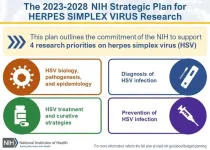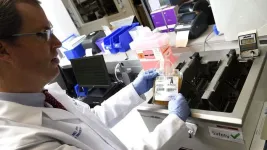(Press-News.org) In a new study, mice whose immune systems were trained against the microbial protein flagellin did not experience the usual detrimental effects of ingesting food additive emulsifiers, pointing to a potential new way to combat various chronic inflammatory diseases. Melissa Kordahi and Benoit Chassaing, Inserm researchers from the Institut Cochin and Université Paris Cité, France, and colleagues present these findings September 19th in the open access journal PLOS Biology.
Dietary emulsifiers are substances added to processed food products to prevent mixed ingredients from separating. Prior research has suggested that eating certain emulsifiers may alter the gut microbiome—microbes that naturally live in the gut—in such a way that enhances some microbes’ ability to invade the protective mucosal lining of the gut, and may lead to chronic intestinal inflammation. Flagellin, a protein expressed by many bacteria that makes up their whip-like flagellae, enabling them to swim and hence conferring motility, may play a key role in promoting such inflammation.
Building on that earlier research, Kordahi and colleagues hypothesized that training the gut’s immune system to target flagellin—immunizing it against flagellin—may help protect against the detrimental downstream consequences of dietary emulsifiers consumption. To test this idea, they immunized mice to flagellin for several weeks and then fed them food containing two common dietary emulsifiers, carboxymethylcellulose (E466) and polysorbate 80 (E433).
They observed that the immunized mice did not experience invasion of microbes into their mucosal lining after ingesting emulsifiers. Moreover, immunization also appeared to protect against chronic intestinal inflammation and metabolic dysregulations normally observed after emulsifier ingestion.
The researchers also note that, after eating food with emulsifiers, the flagellin-immunized mice still experienced changes in the proportions of various microbe species that make up their gut microbiomes. This suggests that the protective effects of flagellin immunization may be related to its effects on microbe function and movement rather than solely an effect on microbiota composition.
More research will be needed to deepen the understanding of the potential use of flagellin immunization and how well these findings might translate to humans in the future. Nonetheless, this study suggests that flagellin immunization could be a potential new strategy to protect against inflammatory conditions that may be promoted by alterations in the host-microbiota interaction, such as inflammatory bowel disease, obesity, and type 2 diabetes.
Chassaing adds, “This study suggests that targeted modulation of the intestinal microbiota can be an efficient way to prevent various chronic inflammatory conditions, such as metabolic deregulations occurring during the consumption of commonly used food additives.”
#####
In your coverage, please use this URL to provide access to the freely available paper in PLOS Biology: http://journals.plos.org/plosbiology/article?id=10.1371/journal.pbio.3002289
Citation: Kordahi MC, Delaroque C, Bredèche M-F, Gewirtz AT, Chassaing B (2023) Vaccination against microbiota motility protects mice from the detrimental impact of dietary emulsifier consumption. PLoS Biol 21(9): e3002289. https://doi.org/10.1371/journal.pbio.3002289
Author Countries: France, United States
Funding: see manuscript
END
A new study shows the isolation and sequencing of more than a century-old RNA molecules from a Tasmanian tiger specimen preserved at room temperature in a museum collection. This resulted in the reconstruction of skin and skeletal muscle transcriptomes from an extinct species for the first time. The researchers note that their findings have relevant implications for international efforts to resurrect extinct species, including both the Tasmanian tiger and the woolly mammoth, as well as for studying pandemic RNA viruses.
The Tasmanian ...
Life on a faraway planet — if it’s out there — might not look anything like life on Earth. But there are only so many chemical ingredients in the universe’s pantry, and only so many ways to mix them. A team led by scientists at the University of Wisconsin–Madison has exploited those limitations to write a cookbook of hundreds of chemical recipes with the potential to give rise to life.
Their ingredient list could focus the search for life elsewhere in the universe by pointing out the most likely conditions — planetary versions of mixing techniques, oven temperatures and baking times — for the recipes to come together.
The process ...
Millions of women are turning to the social media platform TikTok for health advice related to gynecologic cancers, but the majority of that information is misleading or dramatically inaccurate, according to a new study published by The Ohio State University Comprehensive Cancer Center – Arthur G. James Cancer Hospital and Richard J. Solove Research Institute in the journal Gynecologic Oncology.
Senior study author Laura Chambers, DO, says this highlights the power of social media to feed misinformation that could be ...
Alexandria, Virginia — The latest research and advances in otolaryngology-head and neck surgery will be presented in Nashville, Tennessee, during the AAO-HNSF 2023 Annual Meeting & OTO Experience, September 30 – October 4. From among the hundreds of research presentations submitted for the 2023 Annual Meeting, the Annual Meeting Program Committee (AMPC), comprised of physician members, selected 16 Scientific Oral Presentations as the Best of Orals, as well as an additional 40 Late-Breaking abstract submissions that were added to the Scientific Oral Presentation program to offer the latest and most ...
Researchers at the Tufts Lyme Disease Initiative recently received grants totaling more than $7 million to build on an already impressive array of discoveries that Tufts’ teams have made to combat tick-borne diseases.
While Lyme disease can often be successfully treated with antibiotics, 10-20% of patients experience persistent fatigue, joint pain, and mental impairments that last months or years. For some, it is never clear whether symptoms signal persistent infection, reinfection, or malfunction by the body’s immune system.
Researchers ...
Researchers in the University of Delaware College of Health Sciences Department of Medical and Molecular Sciences are playing a pivotal role on the global health stage as they investigate the most common sexually transmitted infection (STI) in the world.
Centers for Disease Control statistics show that 79 million Americans have human papillomavirus (HPV). With 14 million new infections each year, 80% of women will get at least one type of HPV at some point in their lifetime, according to the Office on Women’s ...
WHAT:
In response to the persistent health challenges of herpes simplex virus 1 (HSV-1) and HSV-2, today the National Institutes of Health released the Strategic Plan for Herpes Simplex Virus Research. An NIH-wide HSV Working Group developed the plan, informed by feedback from more than 100 representatives of the research and advocacy communities and interested public stakeholders. The plan outlines an HSV research framework with four strategic priorities: improving fundamental knowledge of HSV biology, pathogenesis, and epidemiology; accelerating research to improve HSV diagnosis; improving strategies to treat HSV while seeking a curative therapeutic; and, advancing research ...
Findings from a nationwide, multicenter study led by Johns Hopkins Medicine and the Johns Hopkins Bloomberg School of Public Health suggest that patients with COVID-19 have less chance of developing post-COVID conditions — commonly known as long COVID — if they receive early treatment with plasma from convalescent (recovered) COVID patients that contain antibodies against SARS-CoV-2, the virus that causes COVID-19.
The new research, first posted online today in mBio, a journal from the American Society for Microbiology, is a follow-up investigation to the 2021 clinical trial that showed convalescent plasma ...
Biomedical research aimed at improving human health is particularly reliant on publicly funded basic science, according to a new analysis boosted by artificial intelligence.
“What we found is that even though research funded by the National Institutes of Health makes up 10% of published scientific literature, those published papers account for about 30% of the substantive research — the important contributions supporting even more new scientific findings — cited by further clinical research ...
Using engineered microbes as microscopic factories has given the world steady sources of life-saving drugs, revolutionized the food industry, and allowed us to make sustainable versions of valuable chemicals previously made from petroleum.
But behind each biomanufactured product on the market today is the investment of years of work and many millions of dollars in research and development funding. Berkeley Lab scientists want to help the burgeoning industry reach new heights by accelerating and streamlining the process of engineering microbes to produce important compounds with ...









